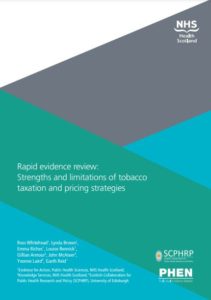
Background
Tobacco use represents the leading preventable cause of morbidity and mortality in Scotland, with around 20% of all deaths attributable to smoking. Smoking-related morbidity and mortality are strongly patterned by socioeconomic group in Scotland, with 35% of adults in the most deprived quintile of the Scottish Index of Multiple Deprivation (SIMD) being current smokers, compared to 11% in the least deprived quintile.
The World Health Organization recognizes that ‘price increases on tobacco products are one of the most effective means of reducing cigarette smoking.’ A wealth of empirical evidence supports this position. A meta-analysis of tobacco price elasticity suggests that a price rise of 10% would lead to around 4% reduction in smoking in high-income countries. In addition, price increases have the potential to reduce health inequalities, as they have a greater impact on quit rates and smoking uptake among those in lower socioeconomic groups. Price increases also represent an approach that is likely to be particularly. Effective among younger people due to increased price sensitivity.
In contrast, the effectiveness of some alternative attempts to reduce tobacco-related harm varies across population groups, which can act to widen health inequalities. For example, mass media campaigns may be more effective among those in higher socioeconomic groups. Tobacco prices are most commonly manipulated for public health benefit via taxation, which at present is generally recognized as both the most effective way of increasing price and of reducing smoking rates.
However, the ability of taxation to achieve public health improvement may change over time or more effective measures may emerge. Indeed, a recent qualitative study of the views of tobacco control experts concluded that further work is needed to explore tobacco pricing policy in Scotland. This rapid evidence review, therefore, examines and summarises the relative strengths and limitations of a number of specific tobacco taxation and pricing strategies. The focus of this review is chiefly on the ability of strategies to affect tobacco prices, given the strong evidence linking price with smoking prevalence.
However, a broad range of additional strengths and limitations are considered. This includes smoking rates, smoking-related morbidity and mortality, public perception and the ability to raise tax revenue.
To read the full document please click the download button.
Ross Whitehead, Lynda Brown, Emma Riches, Louise Rennick, Gillian Armour, John McAteer, Yvonne Laird and Garth Reid

